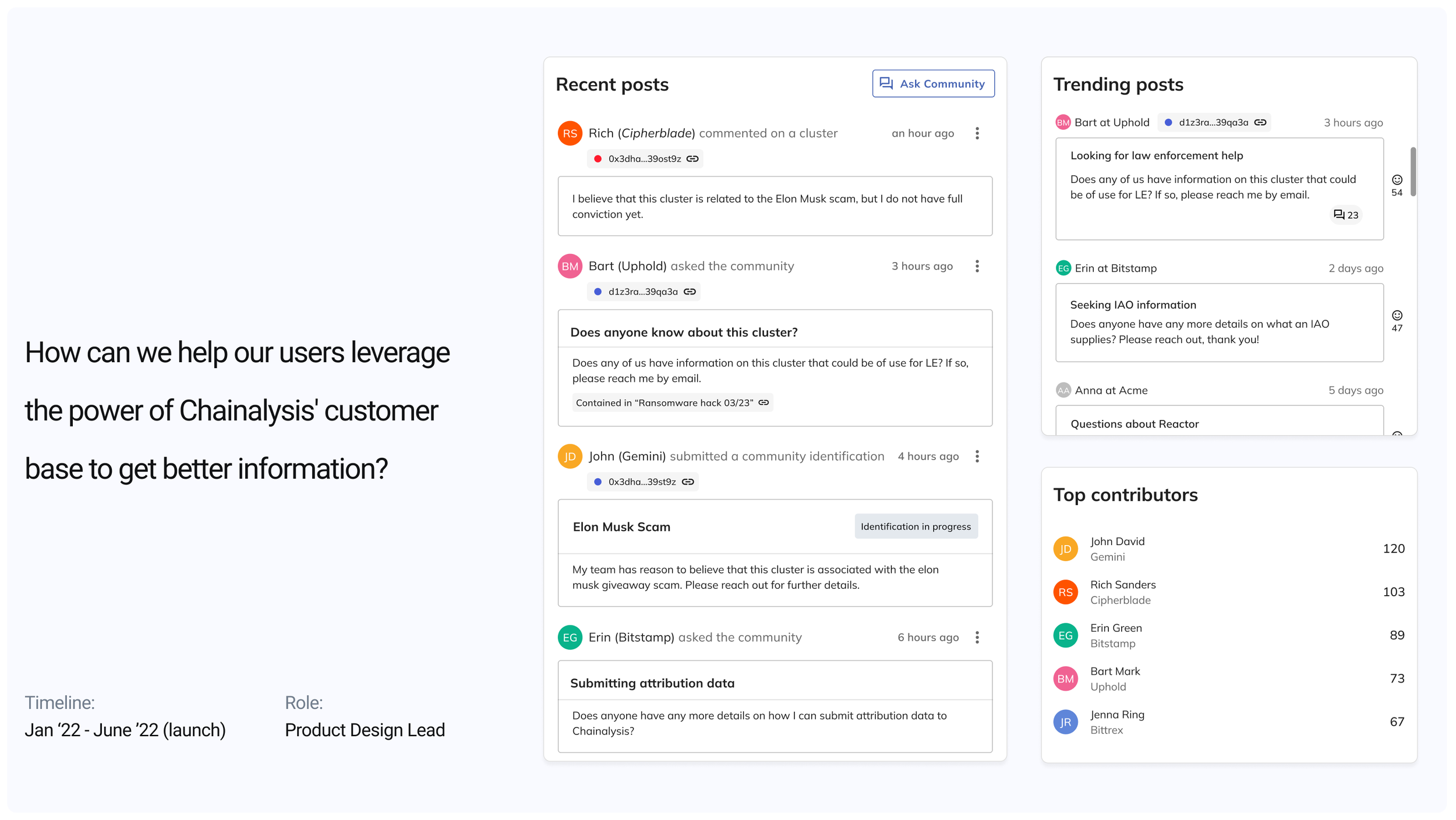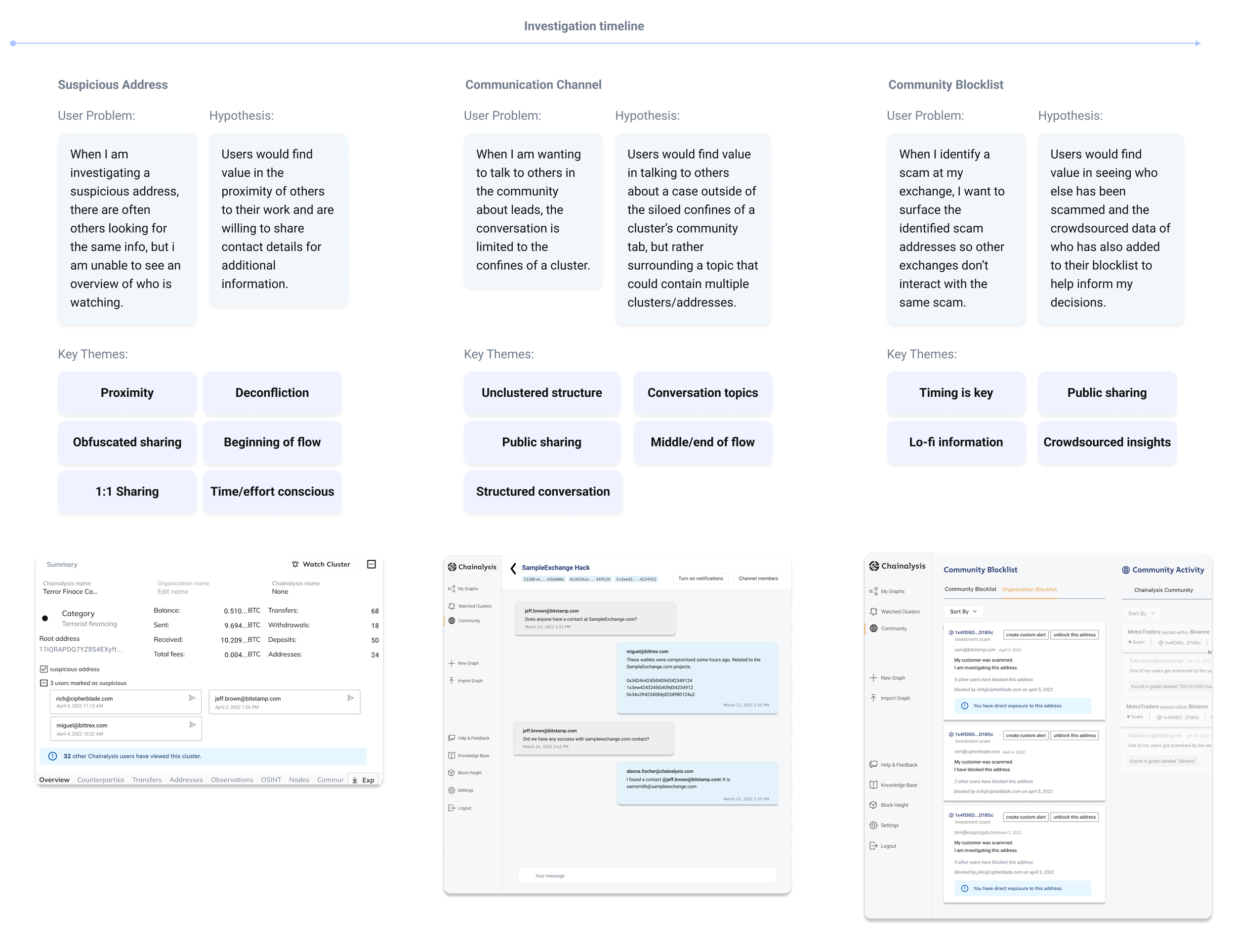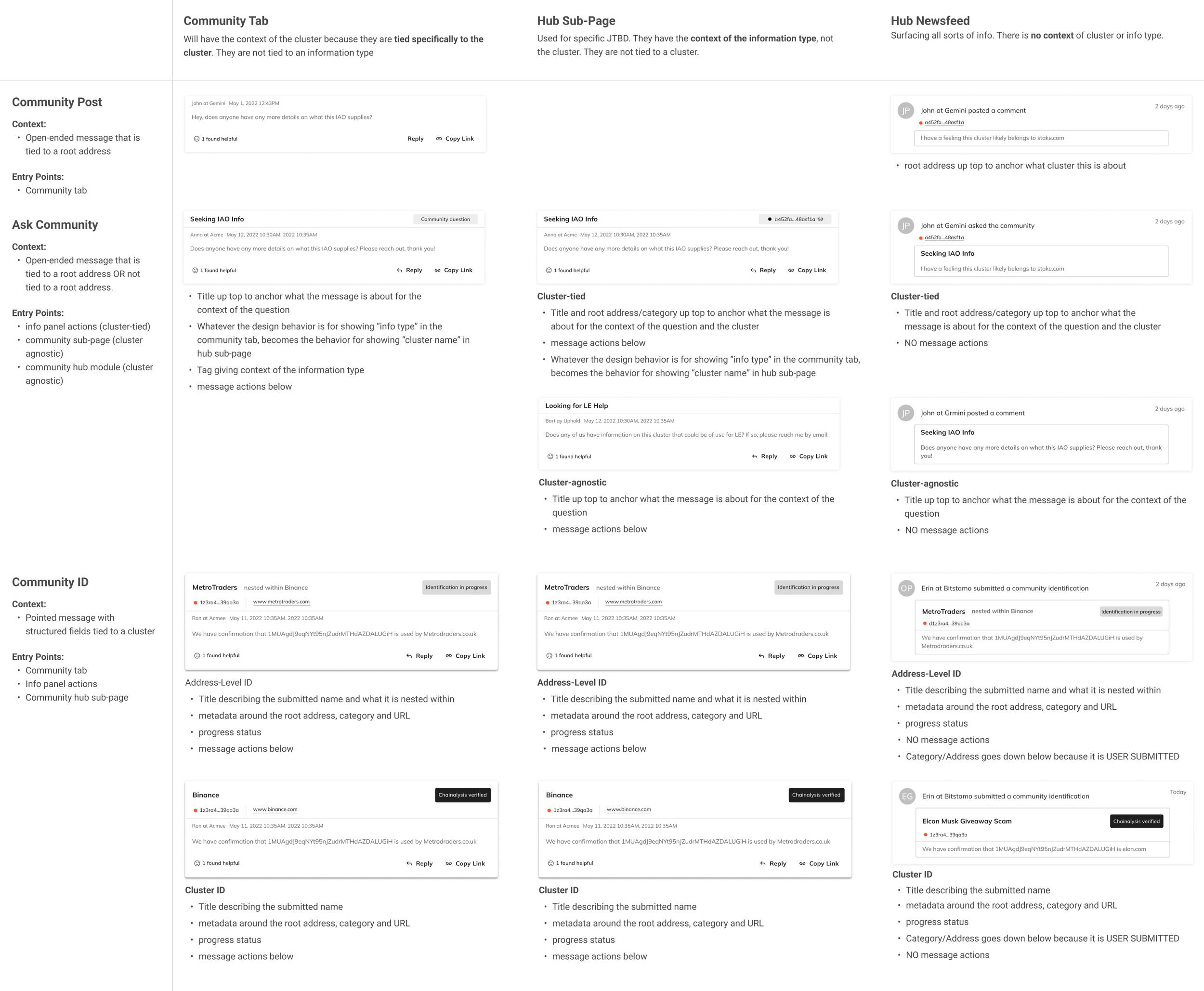The opportunity
Foster a vibrant community by helping investigators leverage the power of the Chainalysis broader customer base & community to them get more, relevant information about a case?
Be a matchmaker by helping investigators quickly find contacts of interest and seamlessly initiate contact?
The problem
Information silos - Investigators aren’t able to leverage the broader knowledge & information that’s out there that could help them with more information about a case.
“Who else out there might have more information about this entity of interest?”
Who and how to contact - Once a lead is identified, there is friction in initiating contact.
“Who do I contact at x and how can I easily contact them?”
If speed is of the essence: Is there a fast way to take action?
Broad to narrow research
Think big: exploring concepts
Resurfacing past research, current metrics, business objectives to understand where to go next with the Community.
How can we take what we’ve learned so far, and create actionable workflows for our targeted audiences?
Research prep: mental models + divergent thinking
Where are there gaps in our workflows today? How do different personas work and collaborate today? Where do we want to unlock new opportunities for them to collaborate in the future?
varying degrees of friction
varying degrees of representation in the cluster view
varying degrees of authenticity
varying degrees of privacy
varying degrees of action in the investigation lifecycle
Research findings
UX research recommendations + outputs
3. Enable follow-up mechanism
Align on best approach for customers to follow up among Direct Messaging, Anonymized Direct Messaging, or Chainalysis Facilitated Communication options.
4. Make it apparent where to contribute
Add “need info” interaction to help guide input to where it’s needed most.
1. Refine “suspicious workflow”
Decouple contact info from suspicious address and make optional.
Explore how workflow best fits together with other mechanisms to contribute info.
2. Launch community hub
Move forward with Community Hub, and populate with content that’s compelling and relevant to the investigations of pragmatists + engaged enthusiasts.
Prioritization of outputs
Output (we will focus on…)
Surfacing relevant information
Matchmaking with “I need help” <> “I can help” workflow.
Capture suspicious activity.
Driving awareness
Feed of community data
Single / clear entry point
Input (how can we provide…)
Relevance
Using on-chain & exposure data.
Harness the broader community to crowdsource.
Awareness & usage
Getting more people aware of and active with the community.
Prioritization of workflows
We started with 3 different workflows,
Identify Cluster, which surfaced relevant scams in a timely manner (important)
Ask Community, which provides a direct relationship for question askers and answerers
Community Watch, which provides a public signal for who is “watching” a cluster
We ended up implementing just the first 2. The rationale being,
Identify Cluster, proven in the data to be a heavily used feature today with a valuable use case in the hub.
Ask Community, here considerable buzz around the channel concept, as well as a need to ask for help. These needs combined seemed like a good jumping off point to test both of those concepts and learn from how they are used to further evolve.
Community Watch, temporarily on hold due to privacy reasons that need to be further explored around, as well as understand how we want government sector to fall into that to really make it powerful.
Composing the hub
User goals
Gain Insights from Community Data
“I am able to leverage the community to generate leads on my case because I am able to see information more upfront.”
“I am able to gain insights from the larger data trends, insights and learnings from the community.”
Relevant Information Surfaced
“When I land on the hub for the first time, I immediately understand the value of the Community.”
“Find community data that is useful/valuable to me and my investigations (relevance / most popular / most recent)”
scams + other identifications
ask community requests
Understand Where to Go, For What
“I have a clear understanding of what Chainalysis deems appropriate to contribute the community.”
“I have a clear understanding of where to contribute different types of information to the community.”
“I have a clear understanding of where to consume different types of information to the community.”
Structuring the IA
What is the most effective way to divide information, considering the IA of not just Reactor, but the whole product suite?
A hybrid approach
Our main question when crafting the hub was around, “How do we direct users to where they want to go/what’s important to them on the hub?” How do we introduce the right balance of recency and relevancy (which can often go hand in hand)? A hybrid dashboard focuses in on the key workflows/JTBD and gives overviews, but opens up to individual feeds for each.
Taking action on the Hub
Now that we have decided to create sub-pages for our two main personas and their respective main needs, we needed to understand what value do we want to display on the hub main page and what actions we want users to take.
How can we leverage Chainalysis’ Community data to facilitate action and provide valuable insights to our users? How can we build these in a cohesive way that will provide value in a series of different ways for different user types?
Module exploration
Turning the atoms data into options modules and weighing them against user problem, potential value, and technical feasibility for an MVP. After recommending modules based on this matrix, I took a look and what would be the optimal combination holistically, each with different focuses we could take on how we want users to engage with community data.











Community MVP
We launched the MVP of the community V2 improvements to all commercial customers on August 4th, 2022, focusing on the two prioritized journeys around..
Reporting Scam or Stolen Funds
As a user, I can more easily share and discover entities that are commonly categorized and have a higher urgency.
Community Help
As a user, I am able to get additional leads & context from those in the Community who may know more
..all while surfacing relevant information that is normally buried at the cluster level, up to a higher level of visibility where users can gain insights more proactively.
UI: A closer look
Designing for Scale
Allowing for community workflows and main JTDB to have their own sub-pages was a design decision to allow for scale and wiggle room.
The flat navigation pattern divides the hierarchy at the root level is curated around the main capabilities of the app to shape the user’s expectations and their mental model of what the app can do.
Designing for standardization
How can we establish consistency and pattern recognition with so many different pieces of data, that all carry different significance in different parts of the product, all while a standardize MUI design library is being built in parallel?
The makeup of a feed
Looking forward
In this MVP of the community hub, the focus was making sure that we can get the right information across and create a baseline UX, while also making tradeoffs with developers to ensure efficiency and not put too much effort in before we know a certain area of the product will be a success. From there, we can learn and gain signal from our users are using the hub, and work towards a more refined feature rich dashboard experience.
What we learned
It has been an incredible learning experience to work with the whole life cycle of such a large project from inception to launch, and one that I have taken a lot of pride in as I’ve been pushing for some of these concepts for some time now.
Some of my biggest learnings have been around the power of guiding decisions with user research, particularly in areas of uncertainty with such large scope.
In retrospect, there were moments where the design process could have been sped up by having certain SME stakeholder inputs added into the equation earlier on. Some, we did not know we’re going to be helpful until mid way through, some we could have identified earlier on to help to the right solution.
There is a time to push back on design decisions with developers, and having that research and user feedback to back your decisions is important. There is also a time to make compromises to help move the product along. Having both an MVP and a north star helps shape those conversations.
Especially when working on a brand new cross-product feature, there is a need to work on things feature by feature in context of the system addition to the wholistic new product itself. Both need to happen in parallel.


















